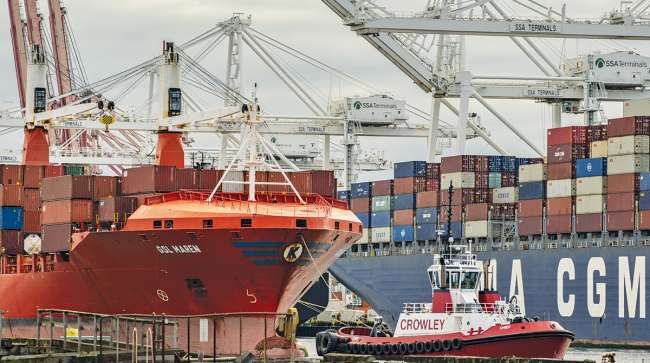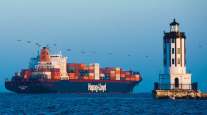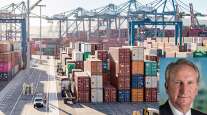Bloomberg News
Ocean Shipping Rates Driving Inflation, Experts Caution

[Stay on top of transportation news: Get TTNews in your inbox.]
Ocean shipping rates are expected to stay elevated well into 2022, setting up another year of booming profits for global cargo carriers — and leaving smaller companies and their customers from Spain to Sri Lanka paying more for just about everything.
The spot rate for a 40-foot container to the U.S. from Asia topped $20,000 last year, including surcharges and premiums, up from less than $2,000 a few years ago, and was recently hovering near $14,000. What’s more, tight container capacity and port congestion mean that longer-term rates set in contracts between carriers and shippers are running an estimated 200% higher than a year ago, signaling elevated prices for the foreseeable future.
Large customers of sea-borne cargo like Walmart Inc. or Ikea have the heft to negotiate better terms in those deals, or absorb the added expense. Smaller importers and exporters — especially those in poor countries — that rely on carriers to haul everything from electronics and apparel to grains and chemicals, can’t easily pass those costs along or weather long periods of stretched cash flows. The situation is throwing a spotlight on the market concentration of shipping lines, and their legal immunity from antitrust laws.
“Small- and medium-sized enterprises are being badly affected,” said Amruth Raj, managing director of Green Gardens, a vegetable processor based in rural India. After container rates shot up in the past year, more than 50% of his company’s capital was wiped out when European buyers balked at the higher costs. “They exploit our desperation.”
In the developing world, it’s not just business survival that’s at stake. Achil Yamen of the Cameroon National Shippers’ Council raised concerns about inequities in Africa on a recent conference call hosted by the United Nations trade body.
“If nothing is done to reverse the trend, the risk in terms of inflation and food security can grow very, very high,” Yamen said.
Meanwhile, the backbone of the postwar march toward globalization is coming through the pandemic in the strongest position in its history — a stark reversal of years losing money in the capital-intensive business. Ocean freight carriers pulled in estimated profits of $150 billion in 2021 — a nine-fold annual jump after a decade of difficulty eking out any gains.
Denmark’s A.P. Moller-Maersk A/S, the world’s second-largest container carrier, was on track for an annual profit last year that would match or surpass its combined results from the past nine years. Its shares hit a record high this month, as did stock in Hamburg, Germany-based Hapag-Lloyd AG, the No. 5 player. The largest, Mediterranean Shipping Co., is a closely held company based in Switzerland that is controlled by Italy’s powerful Aponte family.
Maersk ranks No. 4 on the Transport Topics Top 50 list of the largest global freight carriers, Hapag-Lloyd is No. 14, and Mediterranean Shipping ranks No. 5 on the list.
The extended windfall has touched a raw nerve across the political spectrum as economists warn that persistently high transportation prices are stoking inflation and clouding the recovery. High costs for freight that used to fan only temporary spells of inflation upticks are becoming longer-term features of economies in the U.S. and elsewhere.
Nicholas Sly, an economist with the Kansas City Fed, has done research that found, in the past, a 15% increase in shipping costs led to a 0.1 percentage point increase in core inflation after one year. Shipping rates, he said, currently are a persistent — rather than temporary or transitory — challenge.
“Those types of shocks tend to have lasting effects 12 to 18 months out,” Sly said.
Faced with forces that are upending traditional business models, shippers around the world are pleading with regulators to rein in ocean freight carriers. The latest salvo came Jan. 5 from the British International Freight Association, which called on the U.K. government to investigate “distorted market conditions” within the global container shipping market.
The British freight lobby has pointed to concentration in recent years. Just 10 container lines based in Asia and Europe, led by Maersk, MSC, France’s CMA CGM SA, and China’s Cosco Shipping Holdings Co., control nearly 85% of the capacity for shipping goods by sea. Twenty-five years ago, the top 20 companies controlled about half of the global capacity. CMA CGM ranks No. 8 on the TT Top 50 list of global freight carriers, while Cosco is No. 7.
While officially competitors, nine of them operate under vessel-sharing agreements called “alliances” that coordinate schedules and share space on ships. Meanwhile, carriers have long enjoyed leeway from anti-competition laws in most major economies, including in the European Union and in the U.S.
The Pandemic’s Impact
For the first time, the pandemic demonstrated just how adept the carriers have become at managing the market’s supply of cargo capacity, by curtailing it when COVID-19 first shook the world’s economy and then ramping it up when demand rebounded strongly, driving prices higher than ever. Shippers have chafed at how the alliances’ lock on capacity — the ships, their schedules and speeds, and the millions of steel boxes in circulation — has translated into asymmetric pricing power.
Over the summer, a Pennsylvania-based home decor importer, MCS Industries Inc., filed a complaint against carriers MSC and Cosco before the Federal Maritime Commission, the agency tasked with overseeing carriers in the U.S. The company complained that they “have been operating in tandem to exploit the COVID-19 disruption to profiteer at the expense of U.S. consumers.” MCS reached a confidential settlement with Cosco, while proceedings against MSC are ongoing.
Want more news? Listen to today's daily briefing above or go here for more info
“This market is not working to the benefit of everybody,” said James Hookham, director of the Global Shippers Forum, which represents importers, exporters and cargo owners. “We believe this market needs some investigation to make sure those customers are not being abused.”
Carriers insist the high prices are an anomalous spike born of pandemic-sparked imbalances in supply and demand that will naturally resolve. John Butler, chief executive officer of the World Shipping Council, a group representing the container lines, defended the alliances as arrangements that make the whole system work more efficiently. The council points to strong-than-normal consumer demand in the U.S., and Butler blames many of today’s disruptions on problems with land transportation.
“Pre-pandemic, the situation that we’ve had for the better part of 20 years is plenty of capacity, really low rates and plenty of service,” Butler said. “There’s nothing in the industry as a structural matter that has changed since then.”
Mario Cordero, former chairman of the FMC and executive director at the Port of Long Beach, which is part of the U.S.’s largest port complex, said it’s a “confluence of factors” that have led to the tangling of the global supply chain in the wake of the pandemic. While he expects port congestion and shipping prices to move closer to normalcy in the second half of 2022, he’s still cautious. “I’m not suggesting we’re over this.”
— With assistance from Stephanie Bodoni and Christian Wienberg.




